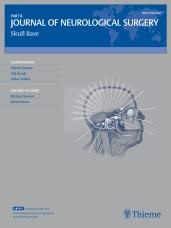In The News
J Neurol Surg B 2017; 78(S 01): S1-S156

DOI: 10.1055/s-0037-1600788
Poster Abstracts
Georg Thieme Verlag KG Stuttgart · New York
Effect of Continuous Left Ventricular Assist Device Blood Flow in a Free Flap 02 March 2017
Perry T. Mansfield 1, Walter P. Dembitsky 2, Michael J. Halls 3, Michael J. O'Leary 1, Natalya Sarkisova 1, Hannah G. Goldman 1, Lauren-Taylor Mansfield 1
- 1 Senta Clinic, San Diego, California, United States
- 2 Sharp Memorial Hospital Cardiothoracic Surgery, San Diego, California, United States
- 3 Alvarado Institute of Plastic Surgery, San Diego, California, United States
Introduction: A patient with radiation failure squamous cell carcinoma of the right temporal bone underwent surgical resection. The defect was reconstructed using a free radial forearm fasciocutaneous flap. The patient’s systemic perfusion was generated by a HeartMate II continuous flow-left ventricular assist device (CFVAD), and implanted pacemaker. The continuous flow device altered typical peripheral perfusion in the post transplanted free flap by attenuating or eliminating pulsatility. This case report discusses the specific findings and outcome of a free tissue transfer in a continuous flow state.
Case Presentation: A 93-year-old male patient, radiation failure, T4N0M0 squamous cell carcinoma of the right temporal bone underwent right lateral skull base resection. Comorbidities of congestive heart failure, end stage cardiac disease necessitated the prior placement of a HeartMate II continuous flow left ventricular assist device and implanted pacemaker. A free left radial forearm fasciocutaneous flap transfer was used for reconstruction of the auricular defect. During surgery, the patient did not maintain a pulse but rather a peripheral continuous flow state. Post free flap transfer, transcutaneous Doppler analysis of perfusion demonstrated a continuous flow pattern for both arterial and venous phases which was maintained throughout the period of post-operative monitoring without incident. The patient had continuous bleeding from the inset and deep margins of the flap. Vascular oozing from multiple raw surfaces was controlled by reoperation after 24 hours, complete flap survival was accomplished. Postoperative hematoma prevention with proper and prolonged drainage systems are essential.
Discussion: The HeartMate II continuous flow left ventricular assist device (CFVAD) is the most widely used LVAD in the world with over 22,000 implants and over 8,000 patients currently being actively supported. Studies observing the CFVAD have linked the device to decreased arterial pulsatility. The Surplus Hemodynamic Energy (SHE) provided by pulsatility becomes increasingly important in both compromised and normal vascular beds as the mean arterial pressure begins to fall below 50 mm Hg. In prolonged perfusion states, with Q=ΔP/R, the inverse relationship shows a decrease in total flow but an increase in vascular resistance. A decrease in flow is directly proportional to a decrease in pulsatile pressure. Reduced pulsatile pressure creates a decrease in nitric oxide production and an increase in oxidative stress. An ischemic cascade develops, with an oxidative perfusion injury following a hypoxic event. The high shear stress of CFVAD mechanical dynamics causes break down of the Von Willebrand macro protein causing decreased platelet binding and a resultant increased bleeding tendency. A common malady in patients with CFLVADs is bleeding which is attributed to the diminished activity of the largest of the Von Willebrand multimers, which serve as a primary ligand facilitating platelet adhesion. This type 2 Von Willebrand syndrome, is an acquired condition that affects the body’s ability to clot.
Conclusion: Free tissue flaps can be successfully used in patients supported by CFLVADs. Anastomotic patency can be monitored using Doppler technology. Extra precautions must be taken to adjust for increased bleeding tendency.
